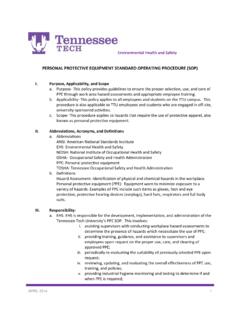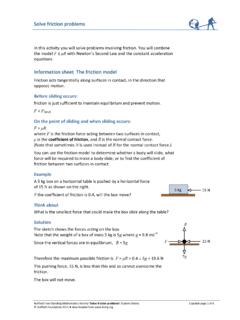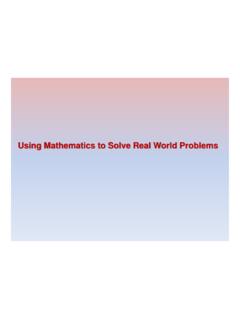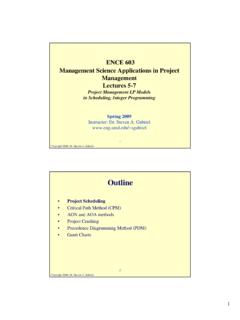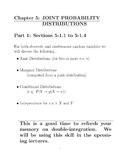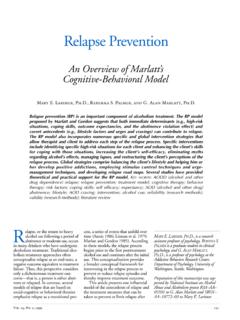Transcription of THE IDEAL PROBLEM SOLVER - Tennessee Technological …
1 THE IDEAL PROBLEM SOLVER THE IDEAL PROBLEM SOLVER A Guide for Improving Thinking, Learning, and Creativity Second Edition John D. Bransford Barry S. Stein rn W. H. Freeman and Company New York Library of Congress Cataloging-in-Publication Data Bransford, John. The IDEAL PROBLEM SOLVER : a guide for improving thinking, learning, and creativity I John D. Bransford, Barry S. ed. p. em. Includes bibliographical references and indexes. ISBN 0-7167-2204-6 (cloth).-ISBN 0-7167-2205-4 (pbk.) 1. PROBLEM solving. 2. Thought and thinking. 3. Creative ability. 4. Learning, Psychology of. I. Stein, Barry S. II. Title. 1993 '3-dc20 92-36163 CIP Copyright 1984, 1993 by W. H. Freeman and Company No part of this book may be reproduced by any mechanical, photographic, or electronic process, or in the form of a phonographic recording, nor may it be stored in a retrieval system, transmitted, or otherwise copied for public or private use, without written permission form the publisher.
2 Printed in the United States of America l 2 3 4 5 6 7 8 9 0 VB 9 9 8 7 6 5 4 3 To J. Rshle~ Bransford and her outstanding namesakes: Rnn Bransford and Jimmie Brown. n n d to Michael, Norma. and Eli Stein CONTENTS PREFACE xiii CHAPTER I THE IMPORTANCE OF PROBLEM SOLVING New Views about Thinking and PROBLEM Solving 3 Some Common Approaches to Problems 7 Mental Escapes I 0 The Purpose and Structure of This Book 12 Notes 13 Suggested Readings 14 PART I A fRAMEWORK FOR USING KNOWLEDGE MORE EFFECTIVELY I 7 CHAPTER 2 A model FOR IMPROVING PROBLEM -SOLVING SKILLS 19 The IDEAL Approach to PROBLEM Solving 19 Failure to Identify the Possibility of Future Problems 22 The Importance of Conceptual Inventions 26 The Importance of Systematic Analysis 27 The Importance of Using External Representations 29 Some Additional General Strategies 30 The Importance of Specialized Concepts and Strategies 3 I.
3 Contents The Importance of Acting on Strategies to Evaluate Outcomes 35 The IDEAL Cycle 38 Blocks to Creative PROBLEM Solving 39 Summary 40 Exercises 41 Notes 48 Suggested Readings 49 CHAPTER 3 CREATIVITY AND THE IDEAL FRAMEWORK 51 Identify Problems and Opportunities 52 Define Alternative Goals 55 Explore Possible Strategies 60 Anticipate and Act 67 Look and Learn 71 The IDEAL Cycle and Creativity 75 Summary 76 Exercises 77 Notes 79 Suggested Readings 81 CHAPTER 4 INTELLIGENT CRITICISM 83 The Importance of Evaluating Arguments 83 Three Ways of Critically Evaluating Arguments 85 The Analysis of Factual Claims 86 Evaluating the Reasoning of Arguments 92 The Analysis of Key Assumptions I 00 Summary I 04 Exercises I 05 Notes I 09 Suggested Readings I I 0 CHAPTER 5 EFFECTIVE COMMUNICATION I I 3 The Importance of Identifying Communication Problems I 13 Three Ways of Defining Communication Goals 114 Message 115 Audience I 16 Presentation Medium 122 Contents-Evaluating the Effectiveness of Your Attempts to Communicate 126 Summary 128 Exercises 128 Notes 129 Suggested Readings 130 PART2 A model FOR ACQUIRING NEW KNOWLEDGE 131 CHAPTER 6 IMPROVING MEMORY SKILLS 133 Remembering as PROBLEM Solving 134 Understanding Basic Memory Processes 137 Strategies for Remembering 144 Adapting and Inventing Memory Strategies 153 Summary 155 Exercises 157 Notes 159 Suggested Readings 160 CHAPTER 7 LEARNING WITH UNDERSTANDING 163 Comprehension as PROBLEM
4 Solving 164 Learning about New Areas of Knowledge 168 Anticipating Outcomes and Acting on Comprehension Strategies 179 Looking at the Effects and Learning to Learn 185 The IDEAL Cycle and Lifelong Learning 186 Summary 187 Exercises 188 Notes 190 Suggested Readings 193 CHAPTER 8 INSTRUCTION THAT FACILITATES PROBLEM SOLVING 195 Why PROBLEM Solving Needs to Be an Integral Part of Education 196 Problems with Traditional Approaches to Instruction 197 -Contents Organizing Learning Around PROBLEM Solving 200 General Issues Related to PROBLEM -Based Learning 208 The Importance of Opportunities for Assessment 21 I Summary 21 3 Notes 215 Suggested Readings 217 CHAPTER 9 CONCLUDING REMARKS 219 The Development of PROBLEM -Solving Skills 220 Attitudes 220 Notes 222 APPENDIX A ANSWERS TO PROBLEMS IN TEXT 223 APPENDIX B ANSWERS TO ExERCISES 22 9 APPENDIX C IDEAL PROBLEM NAVIGATION GUIDE 249 AUTHOR INDEX 255 SUBJECT INDEX 259 PREFACE This book is not simply for people who love the intellectual challenge of solving problems.
5 It is also for people who dislike PROBLEM solving or who feel intimidated by problems. And it is for people who want to help others solve problems. For example, many parents may find this book useful for helping their children perform better in school. Business lead-ers who recognize the importance of skills that enable their employees to identify and solve potential problems may also find this book useful. In addition, we believe that this book can provide a helpful tool for edu-cators and researchers. For example, we have tried to illustrate how knowledge acquisition and knowledge production activities such as class-room teaching and scientific research are instances of PROBLEM solving. By becoming more aware of the processes used to solve problems, people can improve their learning and their abilities to use knowledge to solve new problems that they face.
6 We do not claim that this book will dramatically increase your IQ, make you wealthy, or free you from all personal problems. However, based on our work with high school. college, and even graduate students, and with teachers, administrators, and business leaders, we are confident that you will find something of value that you can use for the rest of your life. It has been our experience that different people find different parts of the book valuable, probably because people have different strengths and weaknesses with respect to PROBLEM solving. Nevertheless, we have not yet met anyone who felt that they learned nothing from this book. We believe that this second edition of The IDEAL PROBLEM SOLVER represents a significant advance over the first edition.
7 In talking and working with people who have used the first edition, we have had the opportunity to focus on the final component of IDEAL : looking at the effects of our earlier efforts and learning from them. We thank the hundreds of people who have given us feedback. Some have shown us how they have creatively applied the IDEAL frame-work to problems such as enhancing their professional growth, improv--Preface ing their grades, and interacting with their children. They have used IDEAL in creative ways that we never imagined and that have taught us a great deal. Others have helped us see the need to clarify the IDEAL framework. In this edition we have modified the framework to make it easier to understand and apply. For example, we have modified both the "define problems" and the "act on strategies" components of the original IDEAL framework.
8 The changes take into account the fact that the way we define our PROBLEM -solving goals affects our perception of problems and constrains the types of strategies we explore. They also reflect the impor-tance of anticipating the outcome of particular strategies before they are fully implemented. The new edition includes many new examples and exercises that will make it easier to understand and apply the IDEAL framework. Finally, we have added a new chapter that explores strategies for improving how schools and organizations prepare people to think and solve problems. This edition has benefited from the efforts of hundreds of dedicated researchers in human thinking and PROBLEM solving. Thanks to them, we now have a better understanding of the nature of PROBLEM solving than we had before.
9 We have tried to keep this book as "user oriented" as possible, and hence we do not spend a great deal of time discussing the scholarly literature on PROBLEM solving. Nevertheless, this literature has had a profound effect on our thinking, and we are grateful to all of the people who contribute to it. It is impossible to thank everyone for the contributions they have made to this book. However, some people have had such a long-term, fundamental impact on our thinking that they deserve special mention. These include Jeff Franks, Jim Jenkins, Bob Shaw, and Walter Weimer. Rick Barclay, Marcia Johnson, and Nancy McCarrell have also made significant contributions to our development. Others who have made major contributions include Ruth Arbitman-Smith, Ann Brown, Joe Campione, Keith Clayton, Reuven Feuerstein, Carl Haywood, and Mil-dred Hoffman.
10 Nevertheless, none of these people should be held respon-sible for any of our mistakes. Some of the people who have played especially strong roles in guiding our thinking for this edition are Linda Barron, Bill Corbin, Jim Dickinson, Linda Giesbrecht-Bettoli, Laura Goin, Elizabeth Goldman, Su-san Goldman, Bob Harwood, Ted Hasselbring, Richard Johnson, Charles Kinzer, Alison Moore, Jim Pellegrino, John Pigg, Victoria Risko, Deborah Rowe, Diana Miller Sharp, Robert Sherwood, Richard Troelstrup, Jim Preface .. Van Haneghan, Nancy Vye, Susan Warren, Susan Williams, and Mike Young. We are also grateful for the opportunity to work closely with many people who completed their graduate training at Vanderbilt-people who taught us a great deal. These include Lea Adams, Pam Auble, Sue Burns, David Chattin, Vic Delclos, Jon Doner, Joan Littlefield, Karen Mezynski, Don Morris, Greg Perfetto, and Nancy Vye.


